My Year with the Takahashi FC-100DZ
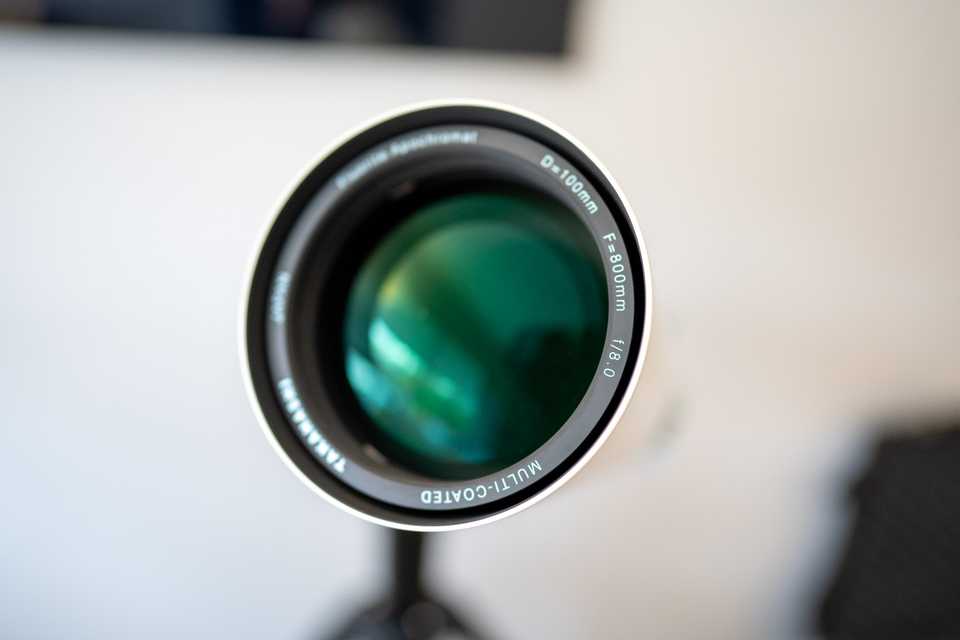
I don’t know if I’m qualified to write a review about anything, let alone a telescope, but I’ve used my Takahashi FC-100DZ extensively over the past year and wanted to write about my experience since I purchased this scope. I’ve used this scope for at least 50 nights in the past year and at least 1000 people have looked through it during the numerous outreach sessions I’ve run, as it rendered views of the moon, Saturn, and Jupiter that mesmerized the public, most of whom have never looked through a telescope before.
Takahashi has been making telescopes since the early 1970s and it shows - everything from the focuser to the clamshell to the sliding dew shield operates with a level of fit and finish that conveys purpose and attention to detail. The glossy cream paint with the mint green clamshell and focuser looks elegant yet understated. The OTA is 3.9kg, heavier than many 4” doublets, but still easy to mount and transport. The optics are made by Canon Optron with a special glass mating element in the front and the fluorite crystal in the back; Takahashi claims that this glass/crystal combo provides excellent performance across the entire visual spectrum above 97.6% Strehl, promising to provide triplet level performance with none of the drawbacks (heavier weight, longer cooldown times, higher risk of going out of collimation, etc.).

When I first got the scope, I paired it with the Stellarvue M2C mount on a carbon fiber tripod from Innorel (LT364C), foolishly thinking that the 35kg listed payload of the tripod would support the setup with ease. Unfortunately, I encountered 3 problems:
- I didn’t buy the pier extension, so the scope hit the tripod legs when I tried to point to the zenith.
- The scope vibrated at magnifications over 100x and made focusing/smooth tracking frustrating and difficult. Ordering vibration reduction pads helped but did not entirely solve the problem.
- The tripod legs don’t have a spreader that allows the legs to extend wider, making my setup feel rather “tippy”. The thought of my scope tipping over and crashing into the concrete is straight from the archives of my nightmares.

Despite the less-than-ideal mounting situation, I observed using this setup for several fruitful months. This scope cools down quickly, typically able to push to higher powers within minutes depending on the seeing, and my first several nights viewing the moon through the DZ from my balcony was nothing short of a revelation; a view so engaging and pure, with masses of detail and spellbinding contrast, mountain peaks and rilles rendered with dimension and depth, crater floors pick-marked with yet smaller craters, that a year later on my desk sits the 21st Century Atlas of the Moon and I consider myself a dedicated lunar observer.
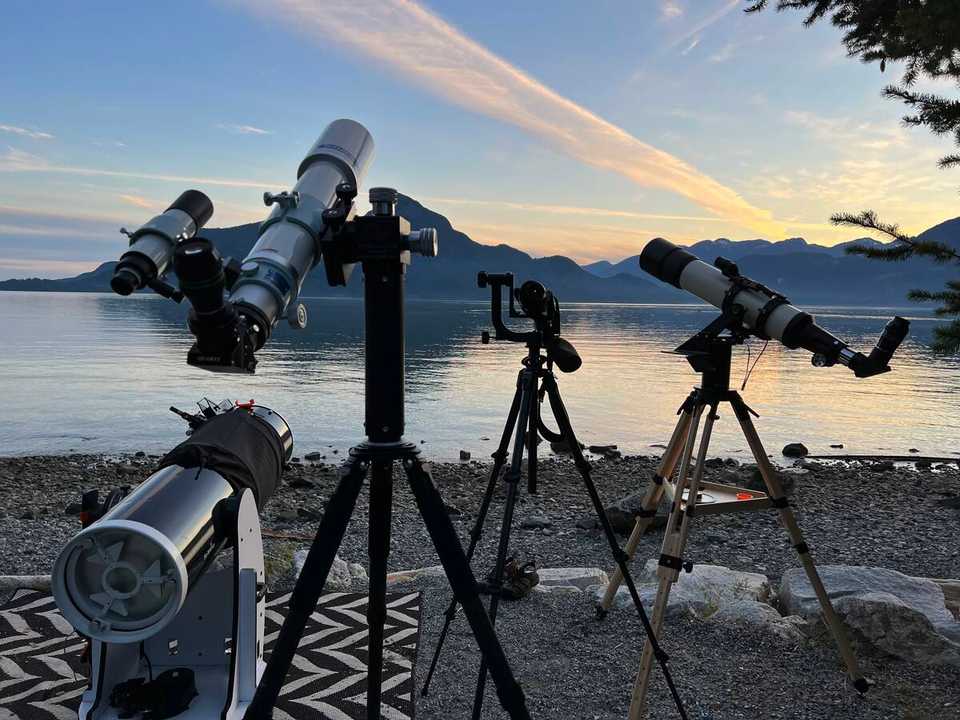
After several months, Saturn and Jupiter became visible in the morning skies, and I woke up early, eager to view the planets through the 4”. The view of Saturn’s rings and Jupiter’s moons are still some of my favourite things to observe. I learned to identify Jupiter’s Galileon moons by their size and colour, as the scope showed them as tiny little disks with a dancing diffraction ring at high powers with no false colour whatsoever. Under good seeing, I regularly observed at 160x and 240x, using the Pentax 5mm and 3.5mm XWs. The wide 70-degree apparent field made manual tracking comfortable with the smooth M2C mount, but I could see the view shaking every time I touched the scope, taking several seconds to dampen. Frustration with the tripod began to mount (excuse the pun) until I went to my local telescope shop Markarian Fine Optics and Harout offered to sell me a used Skywatcher AZ-EQ6 for a great price. I couldn’t resist the appeal of having a rock-solid altazimuth tracking go-to mount with a large 44lb payload capacity and the ability to dual-mount scopes with the extra saddle, so I walked out (or rather, heaved out) of the store carrying the 34lb mount head and 17lb steel tripod.
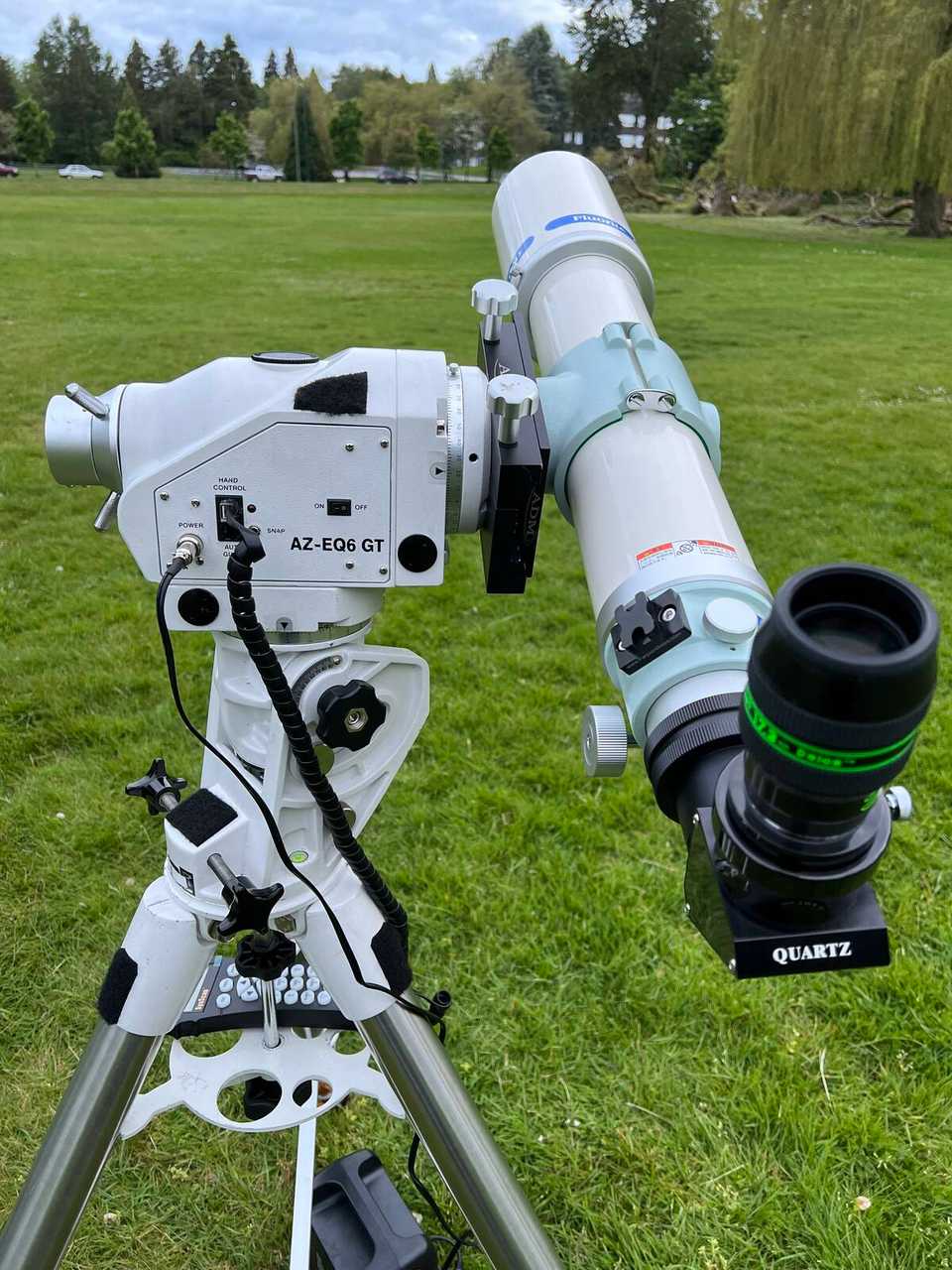
What an upgrade! Now I could tap on the 2” steel tripod legs and the vibrations dampened in a fraction of a second. Focusing at high powers is effortless and the excellent tracking meant the planets/moon remained dead-center for hours, making extended critical observing a pleasure. Outreach is also easier with the tracking mount, as it meant I could talk with people instead of constantly having to nudge the scope to keep objects centered. Finding Uranus and Neptune in light-polluted areas with go-to was a piece of cake. I no longer hand any concerns whatsoever about the scope tipping over.
An unintended bonus of purchasing the AZ-EQ6 was that I could put my m2c mount and pier extension on the beefy steel tripod, converting my previously shaky setup to a rock-solid one. My mounting woes fully resolved, I used the 4” to observe deep sky and solar system objects using a wide range of 2” and 1.25” eyepieces as well as my William Optics binoviewer. Every night, without fail, it delivered superb views of anything that four inches of aperture could be reasonably expected to resolve, including albedo marking and large white clouds on Mars, multiple bands and ovals with subtle texture in the Great Red Spot, the crepe ring in Saturn as well as subtle banding on the planet, and four craterlets in Plato.
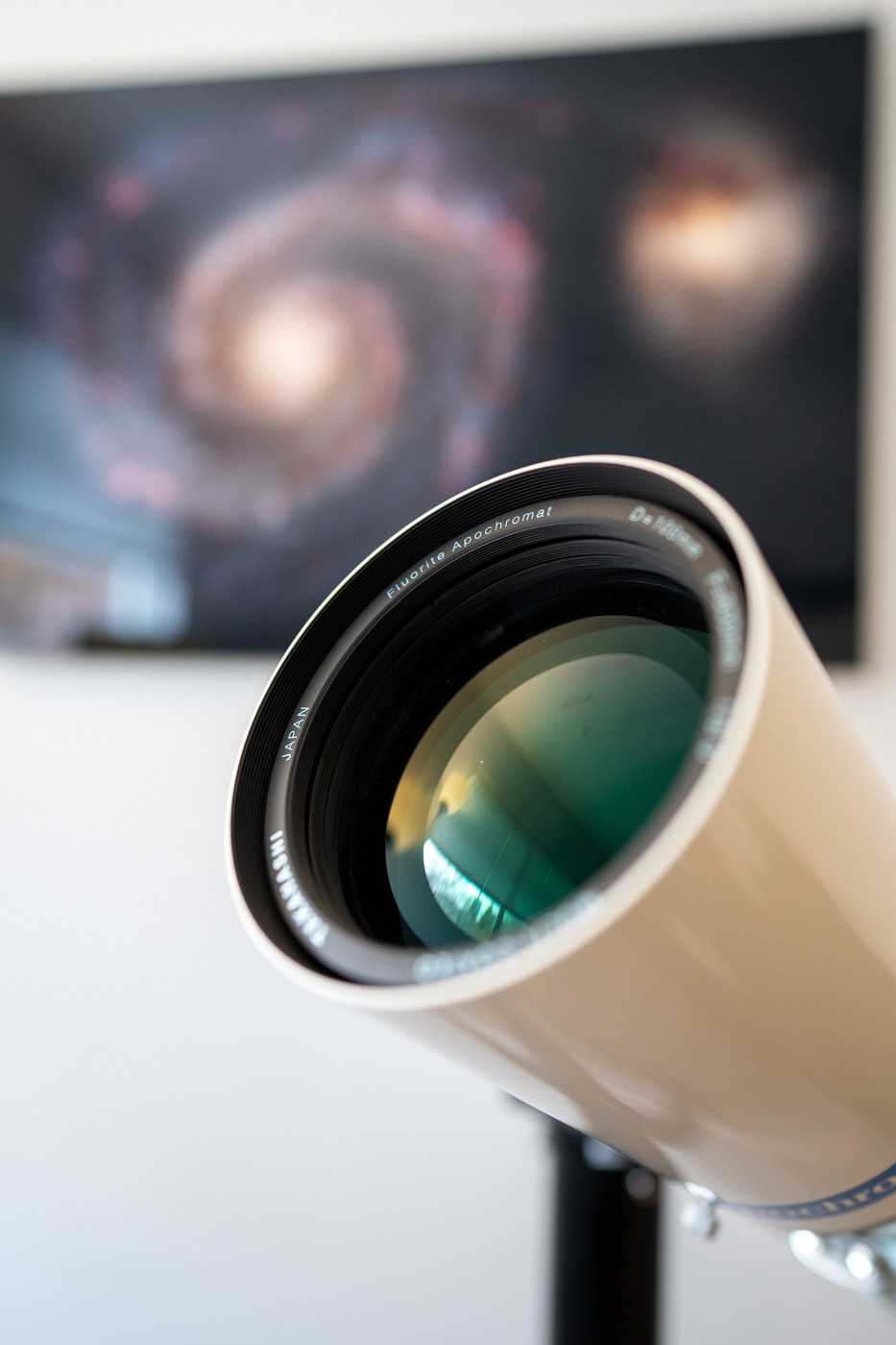
For deep sky, I was impressed by how capable this scope was despite its small aperture - no, it doesn’t show as much detail as a large reflector, but this doublet has exceptional contrast and will eke out every last ounce of performance from the limited photons it can collect. The brighter Messier objects, like M42 and M31, show remarkable detail, and stars are pinpoints right to the edge with well-corrected eyepieces like the Pentax XW and Tele Vue Delos/Nagler. The stars have an intensity and aesthetic in a well-made refractor that is hard to explain and even harder to replicate in other types of scopes. With the 31mm Tele Vue Nagler, the 800mm focal length can show just over 3 degrees true field of view, comfortably framing the entire Andromeda galaxy, and providing a comfortable 3.9mm exit pupil that pairs well with the UHC and OIII nebula filters (I use the Tele Vue Nebustar, OIII, and H-beta filters).
There seems to be mixed opinion on the various forums about Takahashi focusers, with some people hating them and changing them out at great expense for the Feathertouch focusers and others swearing by them. As far as I’m concerned, having used only two Tak focusers (the one on my DZ and more recently on my new FS-60Q), I’m firmly in the 2nd camp - I find the rack and pinion focuser on my DZ to be smooth and precise, with the perfect weighting, making fine focusing a snap even at 300x+. I’ve never touched the tension adjustment because it’s never slipped, even supporting the very heavy Baader 2” Zeiss-spec prism diagonal and the 31mm Nagler, or the binoviewers with a pair of the 13mm Naglers. I’ve had fellow astronomers mention, unprompted, how nice the Tak focuser was to use. I have a Feathertouch on my 15” Obsession and do appreciate its silky smoothness and dual-speed precision but don’t feel any need to swap out my Tak’s focuser.
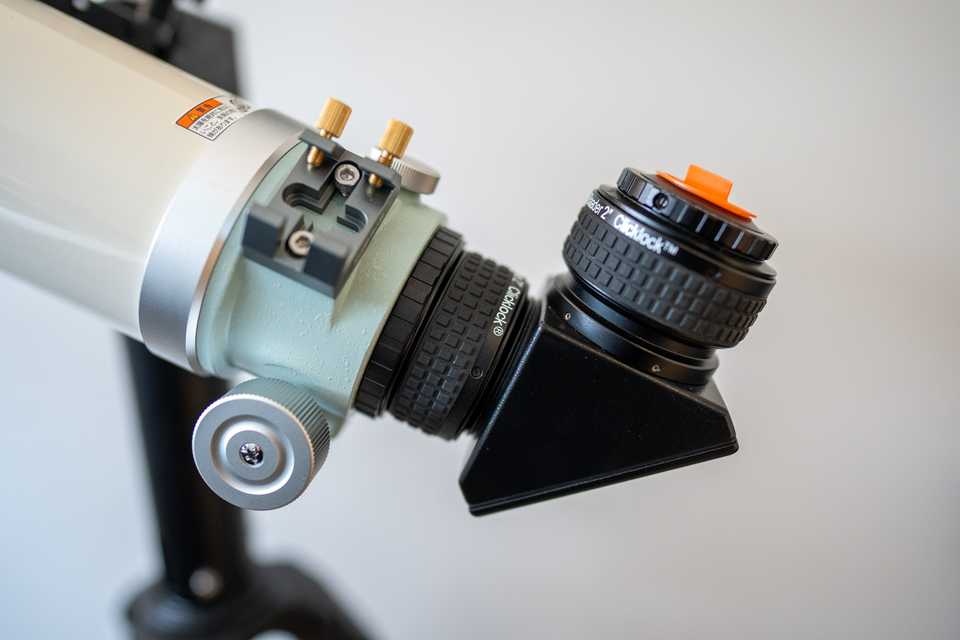
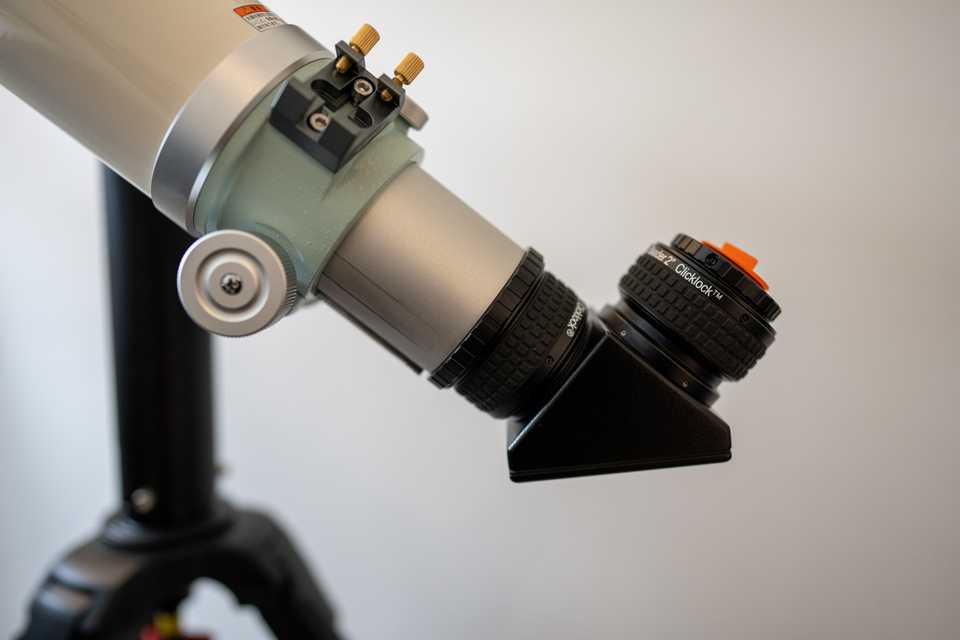
With that being said, I did swap out the standard Tak visual back with the Baader Clicklock clamp for two reasons: the first is that the Tak visual back uses two set screws, which mar diagonals, while the Baader clicklock uses a mechanically satisfying twist-clamping design that clamps down on the diagonal with shocking force. The second is that the Tak visual back is quite a bit longer than the Baader, meaning that my William Optics binoviewer did not have sufficient in-focus when paired with the 1.25” Tak prism diagonal. Having the option to not use the 1.6x glass path corrector means wider field views are possible with the Baader - I highly recommend it. The thread for the DZ is the same as the Sky 90’s M64 thread, part number CLSKY90-2 2956264. I like the Baader clicklock design so much that I also replaced the visual back for both my FS-60Q and my 10” Meade ACF, and purchased a couple of 2” to 1.25” clicklock adapters as well as the 2” Zeiss-spec prism diagonal with clicklock.
A 4” apochromat is the perfect size instrument, small enough to be portable and easy to set up but large enough to show significant detail on the moon and planets. If the seeing forecast is excellent or above average, I still prefer to observe with my 10” Meade ACF - no 4” apo is going to outperform a good 10” of any design - but the fact is that DZ is used far more often, on nearly every clear night, thanks to its portability, quick cooldown times, and superb optics. I’ve become a big fan of fluorite, and in the year since I bought my first (the DZ), I’ve added 3 more to my collection. Yes, this is an expensive telescope, but the DZ is an optically excellent and mechanically beautiful scope that is bound to become a Takahashi classic.
